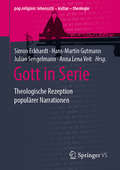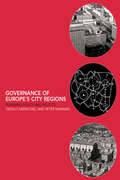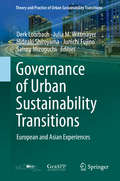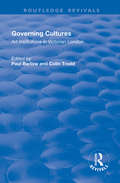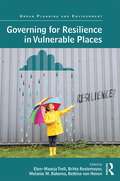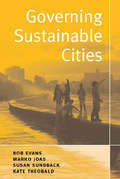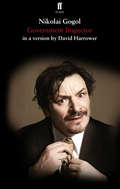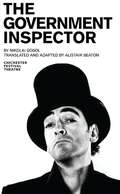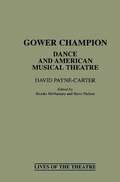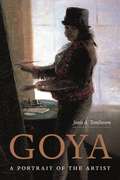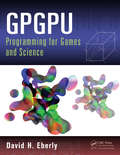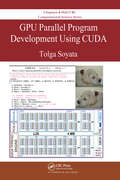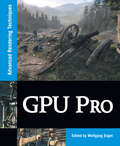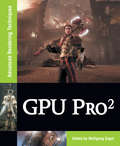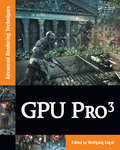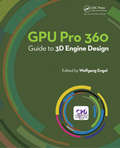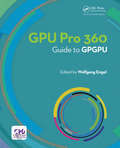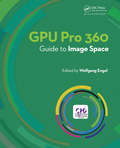- Table View
- List View
Gott in Serie: Theologische Rezeption populärer Narrationen (pop.religion: lebensstil – kultur – theologie)
by Simon Eckhardt Hans-Martin Gutmann Julian Sengelmann Anna Lena VeitDer Sammelband beschäftigt sich mit Serien als festem Bestandteil gegenwärtiger Popkultur, die Erzählmuster bekannter Hollywoodformate ablösen. In den Großerzählungen der Serienlandschaft werden religiöse Themen explizit und implizit verhandelt und zum handlungstragenden Element.
Governance of Europe's City Regions: Planning, Policy & Politics
by Tassilo Herrschel Peter NewmanGovernance of Europe's City Regions considers the changing role of the European Union in regional issues, explores how national governments have become increasingly involved at the regional scale and examines the constitutional and political contexts in which regional and local governments operate. Detailed case studies of regionals in Germany and England illustrate contrasts in European approaches to the scale of government, and the complex interactions of international, national, regional and local scales of policy intervention. The book offers a unique perspective, which links together an analysis of both regional Europe and the local economic and political factors that shape successful regions.
Governance of Europe's City Regions: Planning, Policy & Politics
by Tassilo Herrschel Peter NewmanGovernance of Europe's City Regions considers the changing role of the European Union in regional issues, explores how national governments have become increasingly involved at the regional scale and examines the constitutional and political contexts in which regional and local governments operate. Detailed case studies of regionals in Germany and England illustrate contrasts in European approaches to the scale of government, and the complex interactions of international, national, regional and local scales of policy intervention. The book offers a unique perspective, which links together an analysis of both regional Europe and the local economic and political factors that shape successful regions.
Governance of Urban Sustainability Transitions: European and Asian Experiences (Theory and Practice of Urban Sustainability Transitions)
by Derk Loorbach Julia M. Wittmayer Hideaki Shiroyama Junichi Fujino Satoru MizuguchiReading this book will lead to new insights compelling to an international audience into how cities address the sustainability challenges they face. They do this by not repeating old patterns but by searching for new and innovative methods and instruments based on shared principles of a transitions approach. The book describes the quest of cities on two continents to accelerate and stimulate such a transition to sustainability. The aim of the book is twofold: to provide insights into how cities are addressing this challenge conceptually and practically, and to learn from a comparison of governance strategies in Europe and Asia. The book is informed by transition thinking as it was developed in the last decade in Europe and as it is increasingly being applied in Asia. The analytical framework is based on principles of transition management, which draws on insights from complexity science, sociology, and governance theories. Only recently this approach has been adapted to the urban context, and this book is an opportunity to share these experiences with a wider audience. For scholars this work offers a presentation of recent state-of-the-art theoretical developments in transition governance applied to the context of cities. For urban planners, professionals, and practitioners it offers a framework for understanding ongoing developments as well as methods and instruments for dealing with them. The content is potentially appealing to post-graduate and graduate students of environmental management, policy studies, and urban studies programs.
Governing Cultures: Art Institutions in Victorian London
by Colin TroddThis title was first published in 2000. London in the nineteenth century saw the founding of the National Gallery, the National Portrait Gallery, the Victoria and Albert Museum and the Whitechapel Art Gallery. Other, less permanent, organisations flourished, among them the British Institution, water-colour societies and the Society of Female Artists. These worked alongside the schools such as the Royal Academy and the Slade School of Art. In this volume, eleven scholars, experts on the individual institutions, analyse their complex histories to investigate such issues as: How did they generate and redesign their publics? What identities did they create? What practice of art making, connoisseurship and spectatorship did they enshrine? These reports elucidate the values associated with the key institutions and describe the responses and adaptation over time to major cultural developments: new movements, political change and the development of the Empire. The volume as a whole offers a fascinating account of the interconnections between these key institutions. Challenging conventional readings of the subject, the Introduction, by Paul Barlow and Colin Trodd, offers a definition of public art during the Victorian period.
Governing Cultures: Art Institutions in Victorian London (Routledge Revivals Ser.)
by Colin TroddThis title was first published in 2000. London in the nineteenth century saw the founding of the National Gallery, the National Portrait Gallery, the Victoria and Albert Museum and the Whitechapel Art Gallery. Other, less permanent, organisations flourished, among them the British Institution, water-colour societies and the Society of Female Artists. These worked alongside the schools such as the Royal Academy and the Slade School of Art. In this volume, eleven scholars, experts on the individual institutions, analyse their complex histories to investigate such issues as: How did they generate and redesign their publics? What identities did they create? What practice of art making, connoisseurship and spectatorship did they enshrine? These reports elucidate the values associated with the key institutions and describe the responses and adaptation over time to major cultural developments: new movements, political change and the development of the Empire. The volume as a whole offers a fascinating account of the interconnections between these key institutions. Challenging conventional readings of the subject, the Introduction, by Paul Barlow and Colin Trodd, offers a definition of public art during the Victorian period.
Governing for Resilience in Vulnerable Places (Urban Planning and Environment)
by Elen Maarja Trell Britta Restemeyer Melanie M. Bakema Bettina Van HovenGoverning for Resilience in Vulnerable Places provides an overview and a critical analysis of the ways in which the concept ‘resilience’ has been addressed in social sciences research. In doing so, this edited book draws together state-of-the-art research from a variety of disciplines (i.e. spatial planning, economic and cultural geography, environmental and political sciences, sociology and architecture) as well as cases and examples across different spatial and geographical contexts (e.g. urban slums in India; flood-prone communities in the UK; coastal Japan). The cases present and explore challenges and potentials of resilience-thinking for practitioners and academics. As such, Governing for Resilience in Vulnerable Places aims to provide a scientifically robust overview and to generate some conceptual clarity for researchers, students and practitioners interested in the potential of resilience thinking as well as the application of resilience in practice.
Governing for Resilience in Vulnerable Places (Urban Planning and Environment)
by Elen-Maarja Trell Britta Restemeyer Melanie M. Bakema Bettina Van HovenGoverning for Resilience in Vulnerable Places provides an overview and a critical analysis of the ways in which the concept ‘resilience’ has been addressed in social sciences research. In doing so, this edited book draws together state-of-the-art research from a variety of disciplines (i.e. spatial planning, economic and cultural geography, environmental and political sciences, sociology and architecture) as well as cases and examples across different spatial and geographical contexts (e.g. urban slums in India; flood-prone communities in the UK; coastal Japan). The cases present and explore challenges and potentials of resilience-thinking for practitioners and academics. As such, Governing for Resilience in Vulnerable Places aims to provide a scientifically robust overview and to generate some conceptual clarity for researchers, students and practitioners interested in the potential of resilience thinking as well as the application of resilience in practice.
Governing Sustainable Cities
by Bob Evans Marko Joas Susan Sundback Kate TheobaldUrban governance and sustainability are rapidly becoming key issues around the world. Currently three billion people - half the population of the planet - live in cities, and by 2050 a full two-thirds of the world's population will be housed in ever larger and increasingly densely populated urban areas. The economic, social and environmental challenges posed by urbanization on such a large scale and at such a rapid pace are staggering for local, regional and national governments working towards sustainability. Solutions to the myriad problems plaguing the quest for sustainability at the city-level are equally as diverse and complex, but are rooted in the assumptions of the 'sustainability agenda', developed at the Rio Earth Summit and embodied in Local Agenda/Action 21. These assumptions state that good governance is a necessary precondition for the achievement of sustainable development, particularly at the local level, and that the mobilization of local communities is an essential part of this process. Yet until now, these assumptions, which have guided the policies and programmes of over 6000 local authorities around the world, have never been seriously tested. Drawing on three years of field research in 40 European towns and cities, Governing for Sustainable Cities is the first book to examine empirically the processes of urban governance in sustainable development. Looking at a host of core issues including institutional and social capacity, institutional design, social equity, politics, partnerships and cooperation and creative policy-making, the authors draw compelling conclusions and offer strong guidance. This book is essential reading for policy-makers, politicians, activists and NGOs, planners, researchers and academics, whether in Europe, North America, Australasia or transitional and developing countries, concerned with advancing sustainability in our rapidly urbanizing world.
Governing Sustainable Cities
by Bob Evans Marko Joas Susan Sundback Kate TheobaldUrban governance and sustainability are rapidly becoming key issues around the world. Currently three billion people - half the population of the planet - live in cities, and by 2050 a full two-thirds of the world's population will be housed in ever larger and increasingly densely populated urban areas. The economic, social and environmental challenges posed by urbanization on such a large scale and at such a rapid pace are staggering for local, regional and national governments working towards sustainability. Solutions to the myriad problems plaguing the quest for sustainability at the city-level are equally as diverse and complex, but are rooted in the assumptions of the 'sustainability agenda', developed at the Rio Earth Summit and embodied in Local Agenda/Action 21. These assumptions state that good governance is a necessary precondition for the achievement of sustainable development, particularly at the local level, and that the mobilization of local communities is an essential part of this process. Yet until now, these assumptions, which have guided the policies and programmes of over 6000 local authorities around the world, have never been seriously tested. Drawing on three years of field research in 40 European towns and cities, Governing for Sustainable Cities is the first book to examine empirically the processes of urban governance in sustainable development. Looking at a host of core issues including institutional and social capacity, institutional design, social equity, politics, partnerships and cooperation and creative policy-making, the authors draw compelling conclusions and offer strong guidance. This book is essential reading for policy-makers, politicians, activists and NGOs, planners, researchers and academics, whether in Europe, North America, Australasia or transitional and developing countries, concerned with advancing sustainability in our rapidly urbanizing world.
Government Inspector
by Nikolai GogolThe news that a government inspector is due to arrive in a small Russian town sends its bureaucrats into a panicked frenzy. A simple case of mistaken identity exposes the hypocrisy and corruption at the heart of the town in this biting moral satire.David Harrower's version of Nikolai Gogol's Government Inspector premiered at the Warwick Arts Centre in May 2011 and transferred to Young Vic, London in June.
The Government Inspector (Oberon Modern Plays)
by Nikolai GogolOne of the most famous comedies in world theatre, Gogol's masterpiece has lost none of its bite. In a small town corruption is rife, and the Mayor and his cronies have got it made. So when they learn they are going to be subject to an undercover government inspection they panic. Mistaking a penniless nobody for the inspector they swiftly fall victims to their own stupidity and greed.A dazzling blend of preposterous characters and familiar situations, Nabokov called The Government Inspector the greatest play in the Russian language. A production of this version of the play opened at the Chichester Festival in June 2005 starring the comedian Alistair McGowan.
Gower Champion: Dance and American Musical Theatre (Contributions in Drama and Theatre Studies: Lives of the Theatre)
by David Payne-CarterGower Champion's career spanned the years during which American musical theatre was transformed from a crude popular entertainment into a sophisticated art form. As the director and choreographer of Hello, Dolly!, 42nd Street, and other Broadway musicals, he was central to that transformation. He came of age during the zenith of American musical theatre production and made his mark on both sides of the curtain. As a dancer, he gained notoriety through his work with Jeanne Tyler and Marjorie Belcher, and his experience as a performer gave him a solid foundation for his later success as an organizer of memorable productions. As a choreographer and director, he became known for spectacular numbers that blended dance, staging, and elaborate scenography. More than anyone else, he seemed to realize that the achievement of a musical depended on those spots where music, dance, lighting, costumes, and staging created a sustained narrative and emotional flow through sound and motion rather than words. This book provides the first extensive treatment of Champion's life and legendary career.The book falls neatly into two main sections. The first discusses Champion's career as a performer, with chapters on his early Broadway appearances and his work for MGM Special attention is given to how his experiences as a dancer prepared him for the later half of his career. The second examines his work as a choreographer and director and is organized around the musicals with which he was involved. Each chapter consists of a history of one or more of those productions, from original concept to opening night and sometimes beyond, as Champion, ever the perfectionist, sought to improve on what everyone else thought was already perfect. The volume is fully documented, with basic historical research conducted at several special collections. In addition, the book is based on a careful analysis of Champion's scripts, which include numerous revisions and thus illuminate how he crafted his productions. Finally, the study depends on interviews conducted with various individuals who knew and worked with Champion throughout his impressive career.
Goya: A Portrait of the Artist
by Janis TomlinsonThe first major English-language biography of Francisco Goya y Lucientes, who ushered in the modern eraThe life of Francisco Goya (1746–1828) coincided with an age of transformation in Spanish history that brought upheavals in the country's politics and at the court which Goya served, changes in society, the devastation of the Iberian Peninsula in the war against Napoleon, and an ensuing period of political instability. In this revelatory biography, Janis Tomlinson draws on a wide range of documents—including letters, court papers, and a sketchbook used by Goya in the early years of his career—to provide a nuanced portrait of a complex and multifaceted painter and printmaker, whose art is synonymous with compelling images of the people, events, and social revolution that defined his life and era.Tomlinson challenges the popular image of the artist as an isolated figure obsessed with darkness and death, showing how Goya's likeability and ambition contributed to his success at court, and offering new perspectives on his youth, rich family life, extensive travels, and lifelong friendships. She explores the full breadth of his imagery—from scenes inspired by life in Madrid to visions of worlds without reason, from royal portraits to the atrocities of war. She sheds light on the artist's personal trials, including the deaths of six children and the onset of deafness in middle age, but also reconsiders the conventional interpretation of Goya's late years as a period of disillusion, viewing them instead as years of liberated artistic invention, most famously in the murals on the walls of his country house, popularly known as the "black" paintings.A monumental achievement, Goya: A Portrait of the Artist is the definitive biography of an artist whose faith in his art and his genius inspired paintings, drawings, prints, and frescoes that continue to captivate, challenge, and surprise us two centuries later.
GPGPU Programming for Games and Science
by David H. EberlyAn In-Depth, Practical Guide to GPGPU Programming Using Direct3D 11GPGPU Programming for Games and Science demonstrates how to achieve the following requirements to tackle practical problems in computer science and software engineering:RobustnessAccuracySpeedQuality source code that is easily maintained, reusable, and readableThe book primarily add
GPU Parallel Program Development Using CUDA (Chapman & Hall/CRC Computational Science)
by Tolga SoyataGPU Parallel Program Development using CUDA teaches GPU programming by showing the differences among different families of GPUs. This approach prepares the reader for the next generation and future generations of GPUs. The book emphasizes concepts that will remain relevant for a long time, rather than concepts that are platform-specific. At the same time, the book also provides platform-dependent explanations that are as valuable as generalized GPU concepts. The book consists of three separate parts; it starts by explaining parallelism using CPU multi-threading in Part I. A few simple programs are used to demonstrate the concept of dividing a large task into multiple parallel sub-tasks and mapping them to CPU threads. Multiple ways of parallelizing the same task are analyzed and their pros/cons are studied in terms of both core and memory operation. Part II of the book introduces GPU massive parallelism. The same programs are parallelized on multiple Nvidia GPU platforms and the same performance analysis is repeated. Because the core and memory structures of CPUs and GPUs are different, the results differ in interesting ways. The end goal is to make programmers aware of all the good ideas, as well as the bad ideas, so readers can apply the good ideas and avoid the bad ideas in their own programs. Part III of the book provides pointer for readers who want to expand their horizons. It provides a brief introduction to popular CUDA libraries (such as cuBLAS, cuFFT, NPP, and Thrust),the OpenCL programming language, an overview of GPU programming using other programming languages and API libraries (such as Python, OpenCV, OpenGL, and Apple’s Swift and Metal,) and the deep learning library cuDNN.
GPU Parallel Program Development Using CUDA (Chapman & Hall/CRC Computational Science)
by Tolga SoyataGPU Parallel Program Development using CUDA teaches GPU programming by showing the differences among different families of GPUs. This approach prepares the reader for the next generation and future generations of GPUs. The book emphasizes concepts that will remain relevant for a long time, rather than concepts that are platform-specific. At the same time, the book also provides platform-dependent explanations that are as valuable as generalized GPU concepts. The book consists of three separate parts; it starts by explaining parallelism using CPU multi-threading in Part I. A few simple programs are used to demonstrate the concept of dividing a large task into multiple parallel sub-tasks and mapping them to CPU threads. Multiple ways of parallelizing the same task are analyzed and their pros/cons are studied in terms of both core and memory operation. Part II of the book introduces GPU massive parallelism. The same programs are parallelized on multiple Nvidia GPU platforms and the same performance analysis is repeated. Because the core and memory structures of CPUs and GPUs are different, the results differ in interesting ways. The end goal is to make programmers aware of all the good ideas, as well as the bad ideas, so readers can apply the good ideas and avoid the bad ideas in their own programs. Part III of the book provides pointer for readers who want to expand their horizons. It provides a brief introduction to popular CUDA libraries (such as cuBLAS, cuFFT, NPP, and Thrust),the OpenCL programming language, an overview of GPU programming using other programming languages and API libraries (such as Python, OpenCV, OpenGL, and Apple’s Swift and Metal,) and the deep learning library cuDNN.
GPU Pro: Advanced Rendering Techniques
by Wolfgang EngelThis book covers essential tools and techniques for programming the graphics processing unit. Brought to you by Wolfgang Engel and the same team of editors who made the ShaderX series a success, this volume covers advanced rendering techniques, engine design, GPGPU techniques, related mathematical techniques, and game postmortems. A special emphasi
GPU Pro 2
by Wolfgang EngelThis book focuses on advanced rendering techniques that run on the DirectX and/or OpenGL run-time with any shader language available. It includes articles on the latest and greatest techniques in real-time rendering, including MLAA, adaptive volumetric shadow maps, light propagation volumes, wrinkle animations, and much more. The book emphasizes te
GPU PRO 3: Advanced Rendering Techniques
by Wolfgang EngelGPU Pro3, the third volume in the GPU Pro book series, offers practical tips and techniques for creating real-time graphics that are useful to beginners and seasoned game and graphics programmers alike.Section editors Wolfgang Engel, Christopher Oat, Carsten Dachsbacher, Wessam Bahnassi, and Sebastien St-Laurent have once again brought together a h
GPU Pro 360 Guide to 3D Engine Design
by Wolfgang EngelWolfgang Engel’s GPU Pro 360 Guide to 3D Engine Design gathers all the cutting-edge information from his previous seven GPU Pro volumes into a convenient single source anthology that covers the design of a 3D engine. This volume is complete with articles by leading programmers that focus on various aspects of 3D engine design such as quality and optimization as well as high-level architecture. GPU Pro 360 Guide to 3D Engine Design is comprised of ready-to-use ideas and efficient procedures that can help solve many computer graphics programming challenges that may arise. Key Features: Presents tips & tricks on real-time rendering of special effects and visualization data on common consumer software platforms such as PCs, video consoles, mobile devices Covers specific challenges involved in creating games on various platforms Explores the latest developments in rapidly evolving field of real-time rendering Takes practical approach that helps graphics programmers solve their daily challenges
GPU Pro 360 Guide to 3D Engine Design
by Wolfgang EngelWolfgang Engel’s GPU Pro 360 Guide to 3D Engine Design gathers all the cutting-edge information from his previous seven GPU Pro volumes into a convenient single source anthology that covers the design of a 3D engine. This volume is complete with articles by leading programmers that focus on various aspects of 3D engine design such as quality and optimization as well as high-level architecture. GPU Pro 360 Guide to 3D Engine Design is comprised of ready-to-use ideas and efficient procedures that can help solve many computer graphics programming challenges that may arise. Key Features: Presents tips & tricks on real-time rendering of special effects and visualization data on common consumer software platforms such as PCs, video consoles, mobile devices Covers specific challenges involved in creating games on various platforms Explores the latest developments in rapidly evolving field of real-time rendering Takes practical approach that helps graphics programmers solve their daily challenges
GPU PRO 360 Guide to GPGPU
by Wolfgang EngelWolfgang Engel’s GPU Pro 360 Guide to GPGPU gathers all the cutting-edge information from his previous seven GPU Pro volumes into a convenient single source anthology that covers general purpose GPU. This volume is complete with 19 articles by leading programmers that focus on the techniques that go beyond the normal pixel and triangle scope of GPUs and take advantage of the parallelism of modern graphics processors to accomplish such tasks. GPU Pro 360 Guide to GPGPU is comprised of ready-to-use ideas and efficient procedures that can help solve many computer graphics programming challenges that may arise. Key Features: Presents tips & tricks on real-time rendering of special effects and visualization data on common consumer software platforms such as PCs, video consoles, mobile devices Covers specific challenges involved in creating games on various platforms Explores the latest developments in rapidly evolving field of real-time rendering Takes practical approach that helps graphics programmers solve their daily challenges
GPU PRO 360 Guide to GPGPU
by Wolfgang EngelWolfgang Engel’s GPU Pro 360 Guide to GPGPU gathers all the cutting-edge information from his previous seven GPU Pro volumes into a convenient single source anthology that covers general purpose GPU. This volume is complete with 19 articles by leading programmers that focus on the techniques that go beyond the normal pixel and triangle scope of GPUs and take advantage of the parallelism of modern graphics processors to accomplish such tasks. GPU Pro 360 Guide to GPGPU is comprised of ready-to-use ideas and efficient procedures that can help solve many computer graphics programming challenges that may arise. Key Features: Presents tips & tricks on real-time rendering of special effects and visualization data on common consumer software platforms such as PCs, video consoles, mobile devices Covers specific challenges involved in creating games on various platforms Explores the latest developments in rapidly evolving field of real-time rendering Takes practical approach that helps graphics programmers solve their daily challenges
GPU Pro 360 Guide to Image Space
by Wolfgang EngelWolfgang Engel’s GPU Pro 360 Guide to Image Space gathers all the cutting-edge information from his previous seven GPU Pro volumes into a convenient single source anthology that covers various algorithms that operate primarily in image space. This volume is complete with 15 articles by leading programmers speaks to the power and convenience of working in screen space. GPU Pro 360 Guide to Image Space is comprised of ready-to-use ideas and efficient procedures that can help solve many computer graphics programming challenges that may arise. Key Features: Presents tips & tricks on real-time rendering of special effects and visualization data on common consumer software platforms such as PCs, video consoles, mobile devices Covers specific challenges involved in creating games on various platforms Explores the latest developments in rapidly evolving field of real-time rendering Takes practical approach that helps graphics programmers solve their daily challenges
